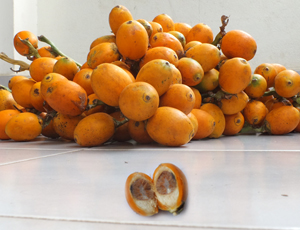Characteristic
Areca catechu is grown for its commercially important seed crop, the areca nut. Penang Island, off the west coast of Peninsular Malaysia, Fua Mulaku in the Maldives, Guwahati in Assam, and coastal areas of Kerala and Karnataka in India, are some of the places named after a local name for areca nut.
Chemical Composition
The seed contains alkaloids such as arecaidine and arecoline, which, when chewed, are intoxicating and slightly addictive. Areca palms are grown in Bangladesh, India, Malaysia, Taiwan and many other Asian countries for their seeds. The seed also contains condensed tannins (procyanidins) called arecatannins
The areca palm is also used as an interior landscaping species. It is often used in large indoor areas such as malls and hotels. It will not fruit or reach full size. Indoors, it is a slow growing, low water, high light plant that is sensitive to spider mites and occasionally mealy bugs. The areca nut is also popular for chewing throughout some Asian countries, such as Taiwan, Vietnam, Philippine, Malaysia, and India and the Pacific, notably Papua New Guinea, where it is very popular. Chewing areca nut is quite popular among working classes in Taiwan. The nut itself can be addictive and has direct link to mouth cancers.[4][5][6] Areca nuts in Taiwan will usually contain artificial additives such as limestone powder.






